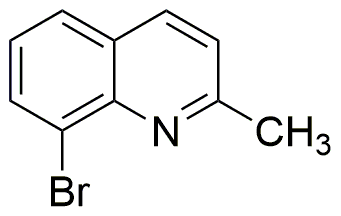8-Bromo-2-methylquinoline is widely utilized in research focused on:
- Pharmaceutical Development: This compound serves as a key intermediate in the synthesis of various pharmaceuticals, particularly in the development of anti-cancer agents due to its ability to interact with biological targets effectively.
- Fluorescent Probes: It is used in the creation of fluorescent probes for biological imaging, allowing researchers to visualize cellular processes in real-time, which is crucial for drug discovery and development.
- Organic Synthesis: The compound is valuable in organic synthesis as a building block for creating more complex molecules, making it essential for chemists working on novel materials or chemical compounds.
- Material Science: It finds applications in the development of advanced materials, including polymers and coatings, where its unique properties enhance the performance and durability of the final products.
- Analytical Chemistry: 8-Bromo-2-methylquinoline is utilized in analytical methods for detecting and quantifying other compounds, providing researchers with reliable tools for quality control and research analysis.
General Information
Properties
Safety and Regulations
Applications
8-Bromo-2-methylquinoline is widely utilized in research focused on:
- Pharmaceutical Development: This compound serves as a key intermediate in the synthesis of various pharmaceuticals, particularly in the development of anti-cancer agents due to its ability to interact with biological targets effectively.
- Fluorescent Probes: It is used in the creation of fluorescent probes for biological imaging, allowing researchers to visualize cellular processes in real-time, which is crucial for drug discovery and development.
- Organic Synthesis: The compound is valuable in organic synthesis as a building block for creating more complex molecules, making it essential for chemists working on novel materials or chemical compounds.
- Material Science: It finds applications in the development of advanced materials, including polymers and coatings, where its unique properties enhance the performance and durability of the final products.
- Analytical Chemistry: 8-Bromo-2-methylquinoline is utilized in analytical methods for detecting and quantifying other compounds, providing researchers with reliable tools for quality control and research analysis.
Documents
Safety Data Sheets (SDS)
The SDS provides comprehensive safety information on handling, storage, and disposal of the product.
Product Specification (PS)
The PS provides a comprehensive breakdown of the product’s properties, including chemical composition, physical state, purity, and storage requirements. It also details acceptable quality ranges and the product's intended applications.
Certificates of Analysis (COA)
Search for Certificates of Analysis (COA) by entering the products Lot Number. Lot and Batch Numbers can be found on a product’s label following the words ‘Lot’ or ‘Batch’.
*Catalog Number
*Lot Number
Certificates Of Origin (COO)
This COO confirms the country where the product was manufactured, and also details the materials and components used in it and whether it is derived from natural, synthetic, or other specific sources. This certificate may be required for customs, trade, and regulatory compliance.
*Catalog Number
*Lot Number
Safety Data Sheets (SDS)
The SDS provides comprehensive safety information on handling, storage, and disposal of the product.
DownloadProduct Specification (PS)
The PS provides a comprehensive breakdown of the product’s properties, including chemical composition, physical state, purity, and storage requirements. It also details acceptable quality ranges and the product's intended applications.
DownloadCertificates of Analysis (COA)
Search for Certificates of Analysis (COA) by entering the products Lot Number. Lot and Batch Numbers can be found on a product’s label following the words ‘Lot’ or ‘Batch’.
*Catalog Number
*Lot Number
Certificates Of Origin (COO)
This COO confirms the country where the product was manufactured, and also details the materials and components used in it and whether it is derived from natural, synthetic, or other specific sources. This certificate may be required for customs, trade, and regulatory compliance.


